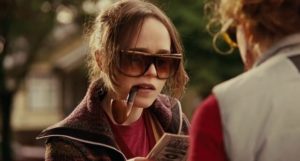The Must-Know Keys to Writing Great Character Descriptions
Great character descriptions are what help ease the reader into your great characterization. They’re the entrée, if you will, to the main event.
If you’re a screenwriter, you know a huge amount goes into the making of a fantastic screenplay. It’s a combination of compelling premise and theme, snappy dialogue and great, original, fascinating characterization.
But why exactly are character descriptions so important?
After all, they seem small and insignificant up against the real bones and meat that make up a screenplay.
Well, we’re here today to answer this important question and give you some key advice on how to make the best character descriptions possible.
But first, we need to break down a few things…
What is a Character Description?
A character description is basically the reader’s first introduction to your character: what they look like, sound like, and act like.
It is essentially the foundation on which the entire character will build. No pressure!
Practically, your character description is made up of two components: your description and your character entrance.
- Your description is a couple quick lines announcing your character for the first time.
- Your character entrance will set the scene through which we see your character.
The combination of these components is critical for crafting your character description. Why? Because it doesn’t just give an image of your character, it gives them a context!
So, now that we know the basics, what should a good introduction do or include? Well it should:
- Provide an adequate profile of what the character looks like.
- Indirectly establish if the character is a minor or major one.
- Give a sense of the character’s personality – we’re looking for depth here!
- Include a character entrance that is meaningful to the character and the story.
- Set the character’s emotional tone.
- Hint at the character’s potential virtues and flaws.
Including all of these points in just a few sentences seems like a difficult task, but it’s an important one.
Just like in life, our first impressions are also lasting impressions. In order to keep audiences engaged, you need a good intro to grab their attention and get them curious about what is to come.
Common Character Description Mistakes
Before you can really understand what to do to write great character descriptions, you need to understand what not to do. Here are some major “don’ts” to avoid:
DON’T be super general or vague
Yes, on a basic level, all you technically need to do in a character description is to, well, describe your character.
- Focusing on general details such as age, hair color, and build is perfectly passable.
- However, none of these vague details really show us any insight into who the character truly is, their motivations, or their role in the story.
For example, if we are looking at a man who is said to be “about 40, average height, with a small build,” we get no real visualization of this character’s personality.
- In fact, not only do we get no personality or insight, we don’t even really get a true idea of their appearance.
Instead, we are left with a generic figure. They could blend into any crowd and naturally won’t stand out to us as a compelling character.
This is exactly what we want to avoid. Instead, we’ll want to craft an image that feels distinct, memorable, and meaningful.
DON’T focus only on appearance
As mentioned in the last point, we want a character description to pull more weight than just serving to introduce a character’s physicality.
- This isn’t to say that the visual isn’t important! On the contrary, the visual is one of the most important pieces in our description.
- But it’s not because it just shows what a character’s body or clothes look like to others, it’s because it demonstrates something internal and integral to who this character is underneath the surface.
Without the latter, we have little more than a character description that meets the bare minimum requirements.
So, it’s important to look at what our example character’s body, age, and clothing looks like. All of these things paint a vivid picture of this character. It gives us a snapshot of who they are, or at least, who they could potentially be.
DON’T have a basic character entrance
The character’s entrance is just as important as the general description you give.
Not only does it provide some extra information about our character, but it also centers what role they might play throughout the rest of the script.
For example, a character introduced while burying a dead body says just as much if not more than what he’s wearing or acting like!
This doesn’t mean you should introduce a character in an intense situation if your screenplay and plot doesn’t call for it. What it does mean though, is that you should avoid incredibly mundane entrances unless that actually says something meaningful about the character.
How to Get Character Descriptions Right
So what should you do to get character descriptions right?
First off, recognize that there’s no one-size fits all for how to write these descriptions.
The approach will vary depending on screenplay structure, your story themes, genre, and will change project by project. That said, there are some key ingredients that almost all fantastic character descriptions incorporate.
Here are some important “dos” to turn your descriptions from good to great.
DO: Establish a sense of personality
It’s been stressed here a couple times, but it bears repeating – do not only give a generic description of what your character looks like!
- To reuse our past example, no one remembers nor particularly cares about a character whose main descriptors are that ‘he is in his 40’s with a small build’.
- However, people will be interested in a character described as a “timid, middle-aged man with a scrawny body and fearful eyes. He’s wearing a pair of 90’s dad jeans 2 sizes too big and a tragically average green polo shirt.”
Why is that descriptor so much more effective?
- It’s because it gives us a character dripping with personality before he even says anything.
- This is no longer a faceless, generic, sterilized figure but rather a character who feels like a real, complex person with flaws and insecurities manifested.
It is now somebody we can connect to, regardless of the fact he doesn’t sound like the most positive character. Also, we can assume certain things about him off his character description alone. This is essential to developing said character.
DO: “Show” not “tell”
“Showing” rather than “telling” is important for elevating a character description from okay to great.
You can communicate what a character is like just by telling the reader, but it lacks specificity and depth. Basically, it leaves a character feeling hollow and it also allows too much room for interpretation.
For example, can you picture The Big Lebowski‘s The Dude just described as relaxed? Would he be the same character if this was the extent of his description? No.
You need to paint a visual picture of The Dude to really translate that character from script to film.
You need to describe the slow loose movements, the long wavy hair, the California, stoner-esque voice, and the ratty flip flops to really understand him as the relaxed, cult-classic character he is.
DO: Leave a sense of mystery
It may seem counter-intuitive and against everything we’re advocating for here, but stick with us.
Choosing to be specific, thorough, and intelligent in how you describe your character is crucial. You want to give readers a fantastic first impression that they can take to.
But, you need to hold back a certain amount as well in order to achieve this.
Character descriptions exist to do just what they say on the tin, but what they’re really there for is to hook the readers and draw them into the story.
- To do this, you need to create emotional investment in the characters. It’s impossible to make this happen if you just lay everything out there from the beginning.
- In the end, you need to keep some kind of distance between the character and the audience.
There needs to be a certain level of mystery. The audience wants to discover more about a character and they can’t do that unless there’s things they don’t know.
So, when writing your description, remember: it’s a snapshot, not the full picture.
DO: Focus on what’s important
Last but certainly not least, one of the major keys to writing a great description is to focus on the important stuff. You are the creator and you need to shape everything.
Not only this, but you need to lead the reader in the direction that you want it. As such, you need to purposefully set the tone and decide who your characters are at their core.
- What is important to them?
- Are they integral to the main plot or are they more of a supporting character?
- What is special about them?
- How do you want the reader/audience to connect and react to them?
- How do they interact with the world and what does that say about them as a person?
All of this will impact how you introduce your characters and how they develop from there on.
Like with any first impression, you are curating the image you want them to take away at the end of the day. Curate it carefully.
Fantastic Examples of Character Descriptions
Take a look at some of these great character description examples and try to find ways you can apply similar techniques in your own screenwriting.
Also, can you think of any other fantastic examples? Leave a comment telling us what other character descriptions you think belong on this list!
- Hell or High Water: “Toby Hanson, late 30’s, a kind face marked by years of sun and disappointment, rides shotgun. It’s not the face of a thief, it is the face of a farmer.”
- The Big Lebowski: “It is late, the supermarket all but deserted. We are tracking in on a fourtyish man in Bermuda shorts and sunglasses at the dairy case. He is the Dude. His rumpled look and relaxed manner suggest a man in whom casualness runs deep.“
- Terminator 2: Judgement Day: “Sarah Connor is not the same woman we remember from last time. Her eyes peer out through a wild tangle of hair like those of a cornered animal. Defiant and intense, but skittering around looking for escape at the right time. Fight or flight. Down one cheek is a long scar, from just below the eye to her upper lip. Her voice is a low and chilling monotone.”
- Warm Bodies: “R (21, undead). Blank face. Sunken eyes. Blueish lips. If we didn’t know any better we’d think he was a junkie, a runaway from the set of My Own Private Idaho. Then we might notice a few thin gashes cutting across his cheeks. And then we might hear a soft groan humming from his frozen lips. And then we might start to wonder…”
- Memento: “The Polaroid camera is lowered, revealing the sweaty, heavy-breathing face of Leonard (mid-30’s). There are droplets of blood across his face. Leonard stares, satisfied, at something on the ground in front of him. There is wet blood on his blue shirt and beige suit. His hand opens and catches a handgun which leaps up into his grasp.”
- What did you think of this article? Share it, Like it, give it a rating, and let us know your thoughts in the comments box further down…
- Struggling with a script? Story analysis is what we do, all day, every day…check out our script coverage services for writers & filmmakers.
Get *ALL* our FREE Resources
Tackle the trickiest areas of screenwriting with our exclusive eBooks. Get all our FREE resources when you join 60,000 filmmakers on our mailing list!






I wanted to read this article but instantly I saw the line: “Your description is a couple quick lines announcing.. ” It is “a couple OF quick lines..” “Different FROM..” (not different THAN!!!!)
Stop murdering the English language. Learn the GRAMMAR and stop contributing to a decadent society